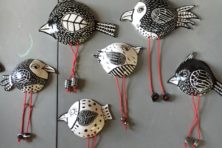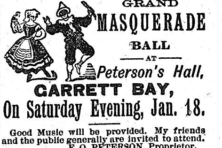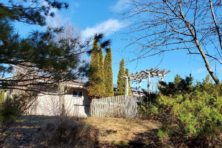Albino Birds
- Share
- Tweet
- Pin
- Share
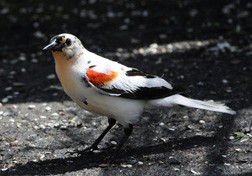
Margaret’s amazingly colored albino Red-winged Blackbird.
Our good friend Margaret from Southern Door contacted us recently to report a partial albino Red-winged Blackbird, something that is rarely reported or seen. You can understand our disappointment, and Margaret’s as well, when the highly unusual bird failed to show up. We had to be in that general area several weeks later so stopped in for another try. No sooner had I set up my camera and tripod next to the glass patio door and the bird feeders when the gaudy creature arrived, hungry and ready to eat and perform.
At first glance the bird appeared as though it was something that a committee, in great disagreement, had put together. What a blotched mixture of mostly white, black feathers here and there, bright red shoulder epaulets, and even some delicate shades of salmon-pink on the chest and belly. However its jerky movements, along with its sharp pointed black beak, were exactly like a Red-winged Blackbird. What a delightful show it put on for us, as it does several times daily for Margaret.
Around 30 years ago, Charlotte and I enjoyed an albino Robin reported to us by friends living along Bay Shore Drive north of Sturgeon Bay. The interesting part of their discovery was that this was the second year in a row one of those rare birds had been seen in their yard.
Unfortunately rain began to fall as we drove toward our friends’ home. They met us at the door with the news that their snow white bird was somewhere in their large yard but they hadn’t seen it for some time.
No sooner had we walked around the bend of their circular driveway when Charlotte spied the little bird huddled about six feet above the ground inside the boughs of a large White Spruce tree, white against the dark green, trying its best to stay dry. Despite the poor lighting, I began popping one picture after another as the soft drizzle continued.

This is how a normal Red-winged Blackbird looks.
Four or five pictures from about 12 feet were all the fair bird would tolerate even though we moved slowly and with great caution. Suddenly the tiny tail-less bird took off and flew about 75 feet over to another taller tree and that ended the picture-taking session. I don’t think the youngster minded our inquisitiveness so much. It was just plain hungry, as most baby birds always appear to be, and there was mama waiting with some food.
That was only the sixth albino bird I had ever seen. The first was a stark-white European Starling flying in with a flock of about 100 normally dark Starlings. Next came an unusually striking adult albino Eastern Kingbird that absolutely refused to pose for a photograph. The exciting actions of a kingbird in pursuit of an insect were greatly magnified by the bird being a dazzling white. Perhaps this bird’s great maneuverability helped it reach adulthood.
A few years later several phone calls arrived over the course of a week during March telling of the sighting of an albino Evening Grosbeak in with a large flock of normally colored Evening Grosbeaks. We couldn’t have been luckier when apparently that very bird arrived at our platform feeder for perhaps less than five minutes in all, but enough for me to capture it on film. It was a partial albino female. She had dark eyes, a wide band of light yellow feathers across her shoulders, and the rest of her body was a creamy white. As we learned through the years, these grosbeaks are known to move a lot between feeders rather than staying for weeks at a time as some birds do.
The next albino was a Robin that was already capable of sustained flight and proved to be quite elusive. I didn’t manage to get a single shot of that wary creature. Perhaps it realized that it was white and a sitting duck for every predator that came along including nosey photographers such as me.
The very next January a blond-colored American Goldfinch visited our feeders for a few days. It too had dark eyes and just a hint of light tan feathers on its back. A baby Robin the following May had pink eyes and perhaps would have qualified as a universal complete albino.

An albino American Robin still has some of its down feathers.
This is a recessively transmitted phenomenon and therefore when it appears it does so in one out of four offspring, on the average, born of apparently unaffected parents. Both parents and two-thirds of the unaffected offspring nevertheless carry an albinism gene which has no detectable effect by itself.
It so happens that parents of albinos are often consanguineous, or blood relatives. Perhaps the Robin parents in our friends’ yard came from the same brood during the consecutive two years. Chances are good too that the parents of that second year’s baby albino were also the parents of the previous summer’s white bird. Robins frequently return to the very same yard to nest.
The pink eyes of the total albino are only apparent, not real. Actually the pupils appear red from light that is being reflected by blood in the un-pigmented choroids within the eyeball. I would assume that should this colorless Robin miraculously survive to breed, which is highly unlikely, with another total albino Robin, that there might be quite a population of white Robins in the county. Remember that the albinos of the Norway or Brown Rat and the House Mouse are the commercial white rats and mice, strains developed by selective breeding, used so extensively in biological research.
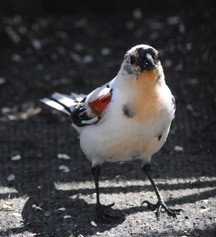
Here is a front view of the albino Red-winged Blackbird.
We’ll always cherish our experience with the first immaculate little stub-tailed Robin that made our day as it presented us with such a lofty and dignified pose in the misty rain. It clearly proved to us that all American Robins aren’t brown and orange.
Time will tell if Margaret’s multi-colored, partial albino Red-winged Blackbird will return to her feeders next year. Surely we’ll hear about it because Margaret is such an excellent birdwatcher and feeder of her birds.
This nature story marks the start of my 45th consecutive year of doing weekly nature stories, first begun on June 20, 1968. With there being so many excellent observers of natural phenomenon, you can rest assured that I’ll be receiving more reports of some amazing albino birds on the wing in our county.

